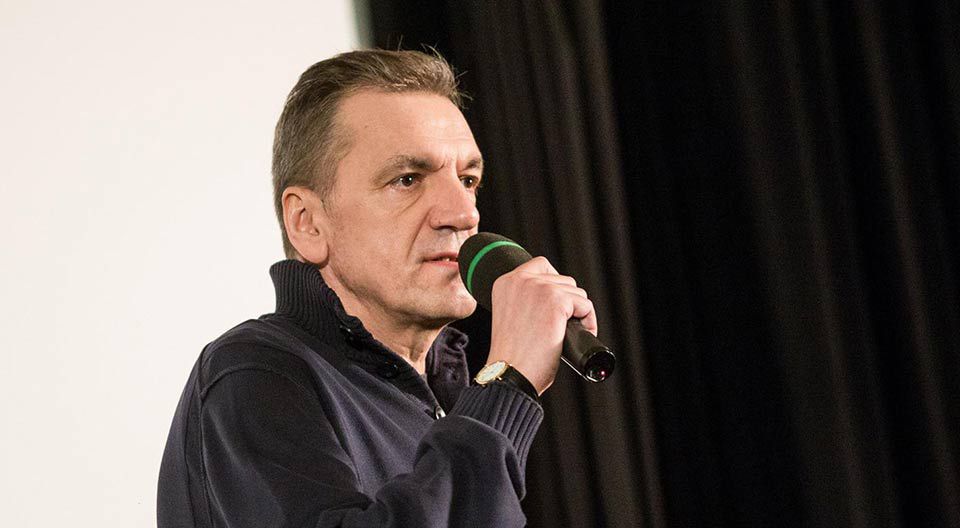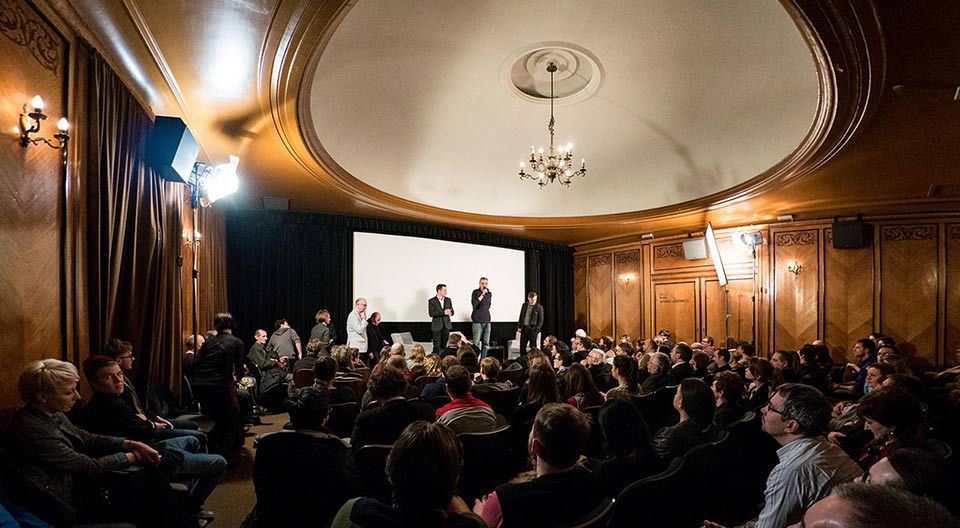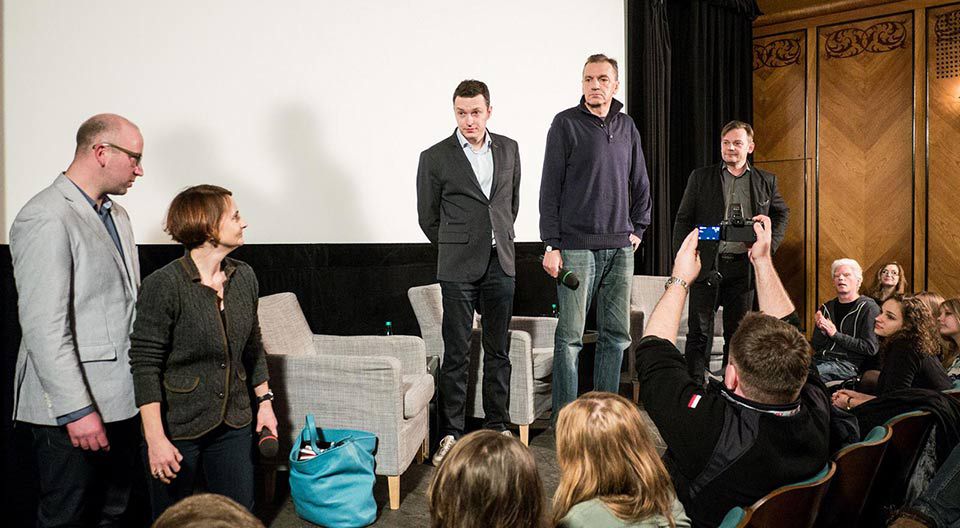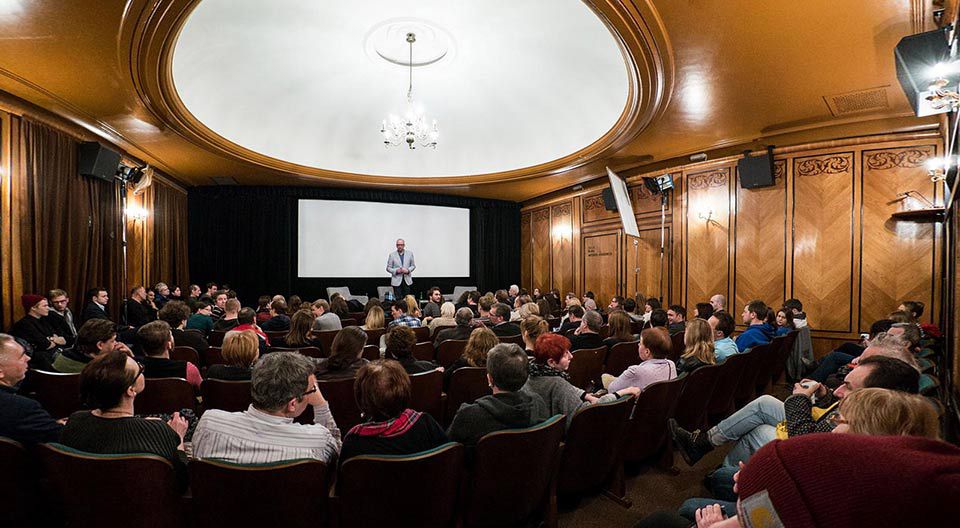10.
02.
2014.
Others
Others
- It’s easier to graduate from this school than to return to it, it took me 25 years - said Władysław Pasikowski during a pre-premiere screening of the film "Jack Strong" at the School Cinema.
On February
6th Władysław Pasikowski had
a meeting with the school audience
after a pre-premiere screening of his latest film "Jack Strong" which was followed by a round of applause. Also other filmmakers involved in the production of the film “Jack Strong” such as Maciej Lisiecki, the cameraman, Ireneusz Czop, an actor (a lecturer of the Acting Dept.) and Jarosław Kamiński, the editor, (head of Lodz Film School Editing faculty) answered the questions of the audience.
About the film’s main protagonist:
- It was a man, who was nothing like James Bond – said the director. – You must remember that the Colonel was not an agent, he was a scribbler, a clerk who would work out all sorts of plans and draw them with crayons on the map. He had no training to be an undercover agent. The conversation during which some Americans instruct him not to wear a uniform to secret meetings is absolutely true. This aspect really struck me – the man, who is not James Bond, must be fulfilling more serious tasks. Mind you, he was the one, who broke his nose walking straight into a post, which he would normally go past, while carrying the most confidential documents from the General Headquarters.
About the chase sequence:
Maciej Lisiecki: - It was for us quite a difficult sequence. Four cameras have been working constantly, cause we were trying to make the sequence look very dynamic: one of the cameras was placed on a quad, the second one was attached to a car, cars would pass over the third one, the fourth one was inside a car. We tried to shoot as many possible takes as we could while being limited for time. We were shooting in winter-time so we only had 6-7 hours of exposure. We organized the work on the shoot in such a way so that it would be enough later on just to have two versions of the same take, and provide more opportunities at the level of editing.
- The film was shot in 35 days, out of which four days were devoted to the sequence described by Maciek - added Władysław Pasikowski, which means the rest of the film was completed in the remaining 31 days plus two extra days in the US.
About research:
Władysław Pasikowski: - I was in a quite comfortable situation to be involved in the project after four years of preparations. I was given a pile of documents which I just had to study. Ms Sylwia Wilkosz, the film’s producer, found some CIA agents and convinced them to reveal their secrets. Then Marcin Dorociński asked them for a meeting too - he would do his own research to find out about Colonel’s behaviour.
About the Russian Embassy:
Władysław Pasikowski: - We wanted to shoot some scenes in the Russian Embassy. Initially we were received in a very friendly way – we were showed round and saw some stunning interiors all in gold and marble – I am not exaggerating. Then we were asked for the screenplay and the moment it has been read we were denied the entry to the Embassy. That was it. I invited some Russian actors to play in the film but these nice people all refused to do it, e.g. Shakurov. I had to turn to some other Russian speaking actors, from former Soviet Union republics e.g. Dima Bilov, who has lived in Berlin for a long time now and who has acted in German films.
About cinematographers:
Władysław Pasikowski: - When I went to work for television, cause there was nothing for me in cinema, Pawel Edelman started his career in the USA working on big film productions. Working for television is quite hard and tiring, cause everybody there knows what a series should look like. I couldn’t just ask Pawel to quit everything in the US and come and work with me for television. I made the series with my camerawoman Magdalena Górka, with whom I has worked for 16 years now, in short, she was promoted to be the director of photography. When I was shooting my next film „Pokłosie”, Pawel was my director of photography as we had agreed ten years earlier. Yes, we made the film together but it was rather exceptional since Magdalena became my director of photography. Then Magdalena Górka shot "Paranormal Activity 3” in the US, which earned 360 million $ round the world, so when she starts making big American productions I’ll make my next film with Maciek Lisiecki, cause it seems to be a natural way of promotion. Paweł, however, is always the one who picks the cameraman. Then again when Maciej starts making films in America, and I will be about to make another film with his colleague, then the colleague will be the one to pick one of you, having seen your films.
Maciej Lisiecki: - I’d like to warn you from the start that Mr Władysław Pasikowski is a very demanding director who only allows one double take so be careful not to waste it.
About acting:
Ireneusz Czop: - I was given two versions of the screenplay, one was shortened and unfortunately the shortenings referred to my part so I wasn’t happy about it. I would sit at home and wonder how to save a few extraordinary sentences. Władysław doesn’t like when the lines get altered because he does not write them to make our acting easier.
About editing:
Jarosław Kamiński: - There were few editing shortcuts in the film, we just narrated the story vividly. When the film was almost edited I watched it again having a closer look at each splice. Strangely enough I found some redundancies totaling at 6 minutes in duration. Władek always writes the screenplay in such a way that the story is told precisely, and at the level of editing we deal with details. The chase sequence is fantastic in the eyes of each editor – I would be happy to use it for educational purposes, of course, if Wladek agrees.
after a pre-premiere screening of his latest film "Jack Strong" which was followed by a round of applause. Also other filmmakers involved in the production of the film “Jack Strong” such as Maciej Lisiecki, the cameraman, Ireneusz Czop, an actor (a lecturer of the Acting Dept.) and Jarosław Kamiński, the editor, (head of Lodz Film School Editing faculty) answered the questions of the audience.
About the film’s main protagonist:
- It was a man, who was nothing like James Bond – said the director. – You must remember that the Colonel was not an agent, he was a scribbler, a clerk who would work out all sorts of plans and draw them with crayons on the map. He had no training to be an undercover agent. The conversation during which some Americans instruct him not to wear a uniform to secret meetings is absolutely true. This aspect really struck me – the man, who is not James Bond, must be fulfilling more serious tasks. Mind you, he was the one, who broke his nose walking straight into a post, which he would normally go past, while carrying the most confidential documents from the General Headquarters.
About the chase sequence:
Maciej Lisiecki: - It was for us quite a difficult sequence. Four cameras have been working constantly, cause we were trying to make the sequence look very dynamic: one of the cameras was placed on a quad, the second one was attached to a car, cars would pass over the third one, the fourth one was inside a car. We tried to shoot as many possible takes as we could while being limited for time. We were shooting in winter-time so we only had 6-7 hours of exposure. We organized the work on the shoot in such a way so that it would be enough later on just to have two versions of the same take, and provide more opportunities at the level of editing.
- The film was shot in 35 days, out of which four days were devoted to the sequence described by Maciek - added Władysław Pasikowski, which means the rest of the film was completed in the remaining 31 days plus two extra days in the US.
About research:
Władysław Pasikowski: - I was in a quite comfortable situation to be involved in the project after four years of preparations. I was given a pile of documents which I just had to study. Ms Sylwia Wilkosz, the film’s producer, found some CIA agents and convinced them to reveal their secrets. Then Marcin Dorociński asked them for a meeting too - he would do his own research to find out about Colonel’s behaviour.
About the Russian Embassy:
Władysław Pasikowski: - We wanted to shoot some scenes in the Russian Embassy. Initially we were received in a very friendly way – we were showed round and saw some stunning interiors all in gold and marble – I am not exaggerating. Then we were asked for the screenplay and the moment it has been read we were denied the entry to the Embassy. That was it. I invited some Russian actors to play in the film but these nice people all refused to do it, e.g. Shakurov. I had to turn to some other Russian speaking actors, from former Soviet Union republics e.g. Dima Bilov, who has lived in Berlin for a long time now and who has acted in German films.
About cinematographers:
Władysław Pasikowski: - When I went to work for television, cause there was nothing for me in cinema, Pawel Edelman started his career in the USA working on big film productions. Working for television is quite hard and tiring, cause everybody there knows what a series should look like. I couldn’t just ask Pawel to quit everything in the US and come and work with me for television. I made the series with my camerawoman Magdalena Górka, with whom I has worked for 16 years now, in short, she was promoted to be the director of photography. When I was shooting my next film „Pokłosie”, Pawel was my director of photography as we had agreed ten years earlier. Yes, we made the film together but it was rather exceptional since Magdalena became my director of photography. Then Magdalena Górka shot "Paranormal Activity 3” in the US, which earned 360 million $ round the world, so when she starts making big American productions I’ll make my next film with Maciek Lisiecki, cause it seems to be a natural way of promotion. Paweł, however, is always the one who picks the cameraman. Then again when Maciej starts making films in America, and I will be about to make another film with his colleague, then the colleague will be the one to pick one of you, having seen your films.
Maciej Lisiecki: - I’d like to warn you from the start that Mr Władysław Pasikowski is a very demanding director who only allows one double take so be careful not to waste it.
About acting:
Ireneusz Czop: - I was given two versions of the screenplay, one was shortened and unfortunately the shortenings referred to my part so I wasn’t happy about it. I would sit at home and wonder how to save a few extraordinary sentences. Władysław doesn’t like when the lines get altered because he does not write them to make our acting easier.
About editing:
Jarosław Kamiński: - There were few editing shortcuts in the film, we just narrated the story vividly. When the film was almost edited I watched it again having a closer look at each splice. Strangely enough I found some redundancies totaling at 6 minutes in duration. Władek always writes the screenplay in such a way that the story is told precisely, and at the level of editing we deal with details. The chase sequence is fantastic in the eyes of each editor – I would be happy to use it for educational purposes, of course, if Wladek agrees.



